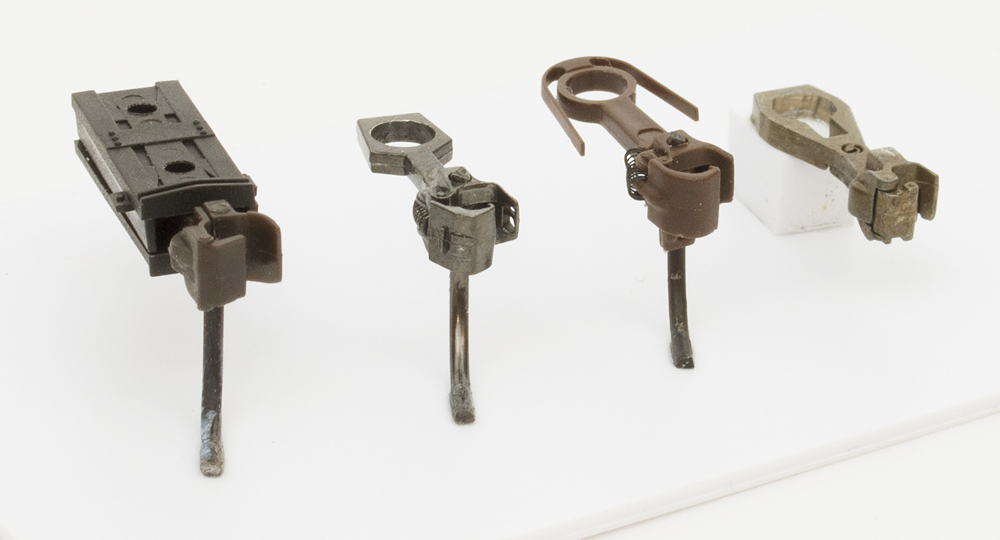Couplers, Wheels and Carriages
Locomotives, freight and passenger cars are collectively known as rolling stock. There is a huge variety of rolling stock available in all scales.
Freight and passenger carriages range from the lower priced to the high-end priced range. The quality of equipment and amount of detail on the carriages can vary greatly.
Some carriages are ready to run straight out of the box while others come in kit form and need to be assembled.
As with most things you get what you pay for, but there are a few points you should look out for:
Attention to detail
Better quality rolling stock will be well detailed with every marking of the prototype.

Figure 37
Wheels that last
Always check the wheels on the rolling stock you are about to buy. Some come with plastic wheels, while others come with steel wheels. The important part is the axle which joins the wheels. This axle should always be steel.
Some plastic wheels can be adjusted on the steel axle. This can be very handy in solving any derailment issues from wheel spacing’s that are incorrect.
Spin the wheels… the wheels should spin freely and not wobble. If the wheels turn half a turn and abruptly stop, then this is a bad sign. If the car is 2nd hand it could be a buildup of dirt or hair around the axle. Cleaning this dirt out could solve the problem.
Steel wheels tend to attract less grime which means less cleaning of the track. They add more weight to the cars which provides more stability, and they give that great clickety train wheel sound.
Plastic wheels tend to attract more dust and grime which means the track will need more frequent cleaning.
Trouble free couplers
As a beginner you may start by coupling and uncoupling your rolling stock manually.

Figure 39
But, when you build that dream layout you are going to want to couple and uncouple “hands-free”. This makes your model trains ‘come alive’ as you shunt the rolling stock around.
Coupling your rolling stock is achieved by shunting the cars together. The couplers are designed to couple together when shunted together.
With the right type of couplers, hands-free uncoupling can be achieved by passing the cars over a un-coupler section in the track. This section is usually operated with a permanent magnet or an electromagnet. This has the effect of
magnetically pulling the steel coupler into a certain position which uncouples the coupler with a little maneuvering back and forth… it’s great fun!
The permanent magnet type of un-coupler is a magnetic metal plate fitted between the rails of that section of track. This type of un-coupler section is usually installed on spurs and sidings to avoid accidental uncoupling if it was installed on the main line.
The electromagnet type of un-coupler is placed underneath the track and only magnetizes when power is applied to the electromagnet. This allows it to be used on the main lines as there is no chance of an accidental uncoupling.
The important point with couplers is to have the same couplers through out. You should never mix couplers, as this could cause derailments.
However, not all couplers are created equal. Here is an overview of the most common couplers and their pros and cons:
This coupler used to be the most common coupler until a few years ago.
They are not a realistic looking coupler, made from plastic and are designed to be manually operated.
There is a pin protruding from the bottom of the coupler and if it is not adjusted properly this will cause derailments. This coupler used to be the most common coupler until a few years ago.
They are not a realistic looking coupler, made from plastic and are designed to be manually operated. There is a pin protruding from the bottom of the coupler and if it is not adjusted properly this will cause derailments.
Lima coupler
Their shapes may be slightly different but the operation is the same. They are a steel coupler and can be uncoupled hands free using an uncoupling ramp.
The disadvantage of this coupler is they need more force than other couplers to couple, so shunting needs to be a bit more violent.
The knuckle coupler is a great realistic coupler that works well with magnetic un-couplers.
The couplers allow close coupling of the rolling stock which does make it harder to uncouple manually with your fingers.
Manufacturers make manual uncoupling tools which work really well.
Kadee manufacture the Kadee knuckle coupler and most enthusiasts won’t use any other coupler… they are that good compared to the other couplers!
You may have the opportunity to buy someone else’s complete model train set with the intention of combining it with yours. Often the couplers will be a different type.
A tip to get around this problem is to create a transition car which is basically a car with your original coupler on one end and the other type of coupler on the other end.
This allows you to run the carriages and standardize the couplers later.
Passenger Carriages
However if you are on a tight budget you can buy the cheaper

Figure 43
passenger carriage which does not have all the interior detail and tint the windows so you can’t see into the carriage.
A small strip of car or house window tinting will do the job. The easiest way to apply the tint is from the inside.
If you turn the carriage over you will notice some screws that can be removed which will remove the truck from the carriage. This will give you access to the inside of the windows.

Figure 44 – Brian Silby’s Layout





